Choosing a trusted membrane switch manufacturer is essential for high-performance electronic interfaces.
Choosing a trusted membrane switch manufacturer is essential for high-performance electronic interfaces.
Blog Article
Everything About Membrane Layer Switch Over: Recognizing Its Layout and Performance
When you consider the control interfaces in modern-day devices, membrane layer buttons typically enter your mind. These components are much more than simply buttons; they blend design and performance flawlessly. Recognizing how they work and what makes them reliable can alter your perspective on daily electronic devices. There are nuances to their design and performance that you might not be aware of. Allow's explore what collections membrane switches over apart from other control systems.
What Are Membrane Switches?

Their smooth nature makes them simple to tidy and resistant to dust and dampness, a crucial feature in many atmospheres. Membrane buttons can likewise be personalized pertaining to shape, dimension, and graphics, enabling manufacturers to create special interfaces customized to specific items. Plus, they're lightweight and thin, which assists in decreasing the overall mass of tools. Generally, membrane switches play a significant duty in boosting user experience throughout a wide selection of applications.
Just How Membrane Switches Work
When you push a key on a membrane switch, it triggers an uncomplicated yet effective device. membrane switch manufacturer. The top layer, typically made of flexible product, presses down onto a conductive layer beneath it.
You'll notice that the tactile feedback differs based on the switch design, using either a soft click or an extra pronounced action. As soon as you release the secret, the membrane layer go back to its initial setting, reopening the circuit and stopping the signal. This procedure occurs virtually immediately, making certain a responsive individual experience.
Membrane layer switches are prominent because of their toughness and resistance to dirt and dampness, making them perfect for different applications, from house devices to medical gadgets. Comprehending this operation helps you appreciate their widespread use.
Key Parts of Membrane Buttons
Comprehending the crucial elements of membrane buttons is basic for understanding their functionality and style. The safety layer guards against environmental variables and wear, prolonging the button's life expectancy. By comprehending these components, you'll get insight right into exactly how membrane layer changes run and their importance in numerous applications.
Materials Used in Membrane Switch Over Layout
The performance and sturdiness of membrane switches greatly depend on the products utilized in their layout. You normally encounter polyester and polycarbonate as main substrates because of their excellent stamina and flexibility. These materials stand up to scratches and chemicals, making them suitable for requiring settings.
The conductive layers frequently make use of silver or carbon, picked for their reliability and conductivity. membrane switch manufacturer. Silver offers superior performance, while carbon is a cost-effective alternative. For the overlay, you may take into consideration a matte or glossy coating, relying on your aesthetic needs and customer experience
Adhesives play an essential duty as well; they bond layers firmly and ensure durability. Make certain to pick adhesives that hold up against ecological elements like temperature and moisture. Ultimately, do not neglect the importance of an excellent printing technique for graphics, as it improves both capability and visual allure. Choosing the best materials will guarantee your membrane switch stands the examination of time.
Style Considerations for Membrane Layer Switches
While creating membrane buttons, it's essential to consider numerous variables that affect their performance and individual experience. Start by concentrating on the design and button dimension; make particular they're instinctive and very easy to browse. Think about the tactile comments you want to offer-- will users require an obvious click or a softer touch? Additionally, believe about the products you'll use, as they'll affect sturdiness and aesthetics.
Do not overlook the graphic design; clear labeling and color contrast are substantial for exposure. Verify your layout suits environmental variables, like dampness or temperature variants, which could affect efficiency. Bear in mind the significance of screening prototypes with actual users to gather responses and make essential adjustments. This repetitive process helps you refine the style, verifying it satisfies both practical and aesthetic demands successfully. By meticulously considering these elements, you'll create a membrane layer button that boosts use and complete satisfaction.
Applications of Membrane Layer Buttons
Membrane layer switches are flexible parts found in numerous applications, from commercial devices to customer electronic devices. You'll see their effect in devices that call for long lasting user interfaces and in gadgets that take advantage of sleek layouts. Recognizing these applications assists you appreciate the capability and functionality of membrane buttons in everyday innovation.
Industrial Equipment Usage
When you're seeking to improve the functionality of industrial tools, membrane buttons supply a reliable solution that combines sturdiness continue reading this with user-friendly style. These switches are best for harsh settings, offering resistance to dust, dampness, and chemicals. You'll discover them in control panels for producing equipments, a/c systems, and clinical gadgets, where precision and responsiveness are essential. Their reduced profile indicates they fit flawlessly right into numerous devices, conserving beneficial room while keeping convenience of use. With personalized graphics and backlighting alternatives, you can develop an instinctive interface for drivers, enhancing effectiveness and security. And also, their long life expectancy lowers upkeep expenses, making them a smart investment for your commercial applications. Accept membrane buttons to simplify your operations and improve overall efficiency.
Customer Electronic Devices Integration
In the domain of consumer electronics, membrane switches play a crucial role in boosting customer communication and tool capability. You'll discover them in tools like microwaves, remote controls, and pc gaming consoles, go to website supplying a smooth way to interact with technology. Their sleek design allows for very easy combination into numerous items, making controls user-friendly and user-friendly. With their ability to integrate graphics and backlighting, you can take pleasure in a modern aesthetic that complements the tool's general look. Membrane switches also assure resilience and resistance to dust and moisture, extending the lifespan of your electronic devices. By picking membrane layer switches, you improve not simply the performance but likewise the design of your devices, making day-to-day communications smooth and satisfying.
Benefits and Drawbacks of Membrane Layer Switches
While membrane switches supply a series of advantages, they also come with some drawbacks that you ought to consider. One considerable advantage is their compact layout, making them optimal for space-constrained applications. They're also cost-efficient, offering a long lasting option with a reduced manufacturing price. On top of that, their seamless surface area is easy to tidy, improving hygiene in atmospheres like hospitals.

Nonetheless, there are downsides. Membrane layer switches can have a much shorter lifespan compared to mechanical switches, particularly under heavy use. They can likewise be less responsive, which could influence customer comments during operation. If damaged, fixing them can be difficult and typically requires total replacement. Eventually, their sensitivity to severe temperature levels and ecological conditions might restrict their effectiveness in certain setups. Stabilizing these pros and disadvantages will aid you establish if membrane switches are the appropriate fit for your project.
Frequently Asked Inquiries
The Length Of Time Do Membrane Changes Usually Last?
Membrane layer changes generally last in between 5 to one decade, depending on usage and ecological conditions. You'll desire to assess variables like wear, direct exposure to moisture, and temperature variations to gauge their long life successfully.
Can Membrane Changes Be Personalized for Certain Designs?
Yes, you can customize membrane switches to fit particular designs (membrane switch manufacturer). You'll have the flexibility to select colors, shapes, and designs that match your project's demands, guaranteeing they blend flawlessly with your overall aesthetic
What Is the Expense Variety for Membrane Switch Over Manufacturing?
The cost array for membrane switch production commonly falls between $1 and $10 each, relying on factors like design intricacy, amount, and products. You can obtain quotes from makers to locate the most effective choice.

Are Membrane Changes Water-proof or Resistant?
Membrane buttons can be created to be water-proof or resistant, depending upon materials made use of and building and construction approaches. If you require them for damp settings, guarantee you specify those requirements during the design process.
How Do Membrane Switches Over Contrast to Traditional Buttons?
Membrane layer switches are normally thinner and more versatile than traditional buttons, using a sleek layout. They're typically easier to clean and integrate, but may not supply the tactile comments you're made use of to with mechanical choices.
Final thought

Report this page